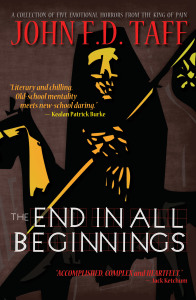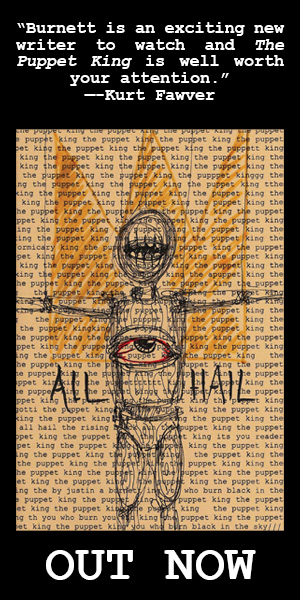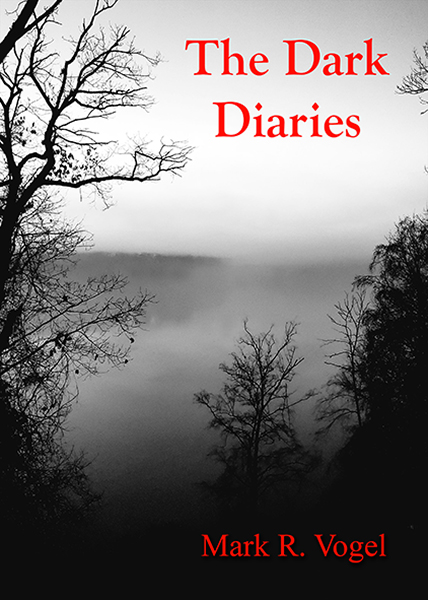
Let me first say that I might not be the best qualified writer to enter this discussion. In my entire ouevre of half a dozen novels and 75 short stories, I’ve only got two entries in this genre. One is short story entitled “Angie,” that you can find in the Grey Matter Press anthology Ominous Realities. The other is a novella featured in my recently published novella collection The End in All Beginnings, also from Grey Matter Press.
So zombies, as a horror subject, feature in a very, very small amount of my output. Still, zombies are a powerful trope in horror these days, perhaps the most powerful in this post-vampire overload world we live in. Zombies, it might be said, represent one of only two modern day monsters I can think of, the other being the eldritch creatures of Lovecraftian design.
I remember the first time I was exposed to zombism, on that excellent episode of Kolchak: The Night Stalker inelegantly titled “The Zombie.” I was 10 years old when I saw this, and I remember being absolutely terrified (in a great way!), especially the sequence when Kolchak climbs into the back of the abandoned hearse in the junkyard. He fills the zombie’s mouth with salt and then starts to sew it up. Of course, I was practically sweating waiting for the creature to wake up, which, of course, he did, sending Kolchak scurrying from the hearse and me scurrying to the bathroom squirting pee along the way.
These zombies were different from the other horror creatures I’d grown accustomed to. Not elegant and bloodthirsty like the Dracula of the Universal or Hammer films. Not driven and sad like Frankenstein, nor feral like the Wolf-Man. Nor even cursed and unstoppable like the Mummy. These creatures were inexplicable to me; resurrected dead shambling around with little but carnage on their mind.
I hadn’t seen Night of the Living Dead in its first run. I was far too young and Catholic to be allowed to do that, even though my mother was (is) a die-hard horror movie fan. No, by the time I saw that movie, sometime in my later teens, whatever shock value it had once possessed was long gone for me. Sort of like The Exorcist. By the time I saw it, it seemed very ridiculous. The scariest thing about that particular movie, for me at least, is the memory of my parents coming home late one night and my father—my ex-Marine and police officer—being pretty freaked out about it.
I didn’t much think of zombies after that episode of The Night Stalker, at least until Romero resurrected them for his sequel, Dawn of the Dead in 1978. I was only 15 at this time, but looked older and therefore could get myself into R-rated movies easily. What a mistake that was. This is where I tell you a closely guarded secret of mine, one that I relate in the notes of my collection, The End in All Beginnings. I have a very weak stomach for bloodletting. There, I said it. Yes, it’s embarrassing for a horror writer, but there it is.
Dawn of the Dead had some truly horrific, bloody scenes, some of the absolute bloodiest I had ever seen up to that point. I stayed and watched the entire picture, but was fairly queasy upon exiting the theater. I’d have probably walked out, but at that age leaving the theater didn’t enter my mind. It did, later in life, upon viewings of The Re-Animator and (this is really embarrassing) Interview with the Vampire. I know. It’s humiliating. And it hasn’t gotten any better. I saw Gone Girl recently, and had to shield my eyes like a nine-year-old girl during one scene.
Anyway, that kind of began my disinterest with zombies. A few years later, I read The Serpent and the Rainbow and saw the movie with Bill Pullman. I thought it was effectively scary, but fairly unbloody. Maybe I could get back into zombies? But no, then came Romero’s relentless pursuit of the ultimate blood bacchanalia—Day of the Dead, Land of the Dead, Diary of the Dead. Ugh. The thousands of gallons of fake blood and squishy internal organs.
It seemed that, during the 80s and 90s, the only zombies I could stand were their scifi counterparts, the Borg in Star Trek: The Next Generation—intense, driven, all-consuming, yet totally bloodless.
But things come full circle eventually, don’t they? Lately, I’ve been exposed (heh) to the works of Joe McKinney, who I think is a fine horror author and a master of the zombie genre. And though I don’t watch it religiously, I’ve seen episodes of The Walking Dead. But, and here’s the thing—the big difference between the older monsters and today’s zombies—I think the best use of the zombie motif is when they’re part of the backdrop, not part of the foreground.
Strange to think of it that way. You wouldn’t really be excited, say, about a book or movie where Dracula or Frankenstein are background characters. No, most horror monsters need to be out front, shaping the story, clearly putting the antagonize in antagonist.
But authors like McKinney know that the real horror of zombies becomes apparent when you place a real, human story against the background of hordes of flesh-eating creatures. That setting amplifies what an author is trying to do in the foreground, creating a real dissonance that adds to the horrific atmosphere. I was at the World Horror Convention in New Orleans in 2013 and had the opportunity to hear Joe read his short story “Bury My Heart at Marvin Gardens.” It’s a terrific short, but the zombies are window dressing for the real heart of the story. It was a tricky read for Joe, as the story holds deep personal meaning for him. But it was a wrenching, emotional reading, and I felt honored to be hearing it.
That use of zombies to focus and accentuate a human story is what I shot for while writing my two forays into this genre, “Angie” and “Love in the Time of Zombies.” Both, in fact, are really love stories at their centers. “Angie” is the story of an older love, told through two divorced characters who still care deeply for each other. “Love in the Time of Zombies” is the ultimate tale of unrequited love. In each, the zombies are there, doing their zombie thing, but they’re not front and center. The story—the main characters and their conflicts—are at the center of each, and the zombies are there, in my mind, to ratchet things up a bit.
And I guess, for me, that’s where I’m comfortable having zombies, at least in my writing milieu—in the background, in the distance. Oh sure, you’re aware of them. You know what they’re doing, what they’re capable of doing, what might happen at any moment in the story. But the focus isn’t on them. The story’s not written just to show blood and gore and body parts being ripped off and head shots and decapitation. These things happen, let’s be real, even in my stories. It’s just not the main focus.
Will you enjoy “Love in the Time of Zombies” or “Angie” if you’re a zombie lover? I think so. Give them both a try. Pick up copies of The End in All Beginnings and Ominous Realities. I don’t think you’ll be disappointed.
Will I write more zombie stories? I dunno. I guess it just depends on whether the story I’m trying to tell needs the kind of undertone these modern monsters bring to the table. But it’s nice to have them in the arsenal all the same.

You can find out more about Taff below:
“Literary Horror Makes Comeback in The End in all Beginnings†Press Release
http://greymatterpress.com/literary-horror-makes-comeback-in-the-end-in-all-beginnings-by-john-f-d-taff/
The End in All Beginnings Product Page at Grey Matter Press
http://greymatterpress.com/books/the-end-in-all-beginnings-john-f-d-taff/
John F.D. Taff Author Website
http://johnfdtaff.com/
Amazon Author Page – John F.D. Taff Amazon Author Page
http://www.amazon.com/John-F.D.-Taff/e/B005C6BZMY/ref=ntt_athr_dp_pel_pop_1




